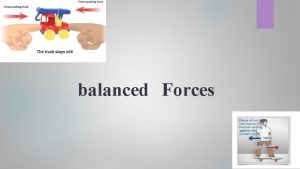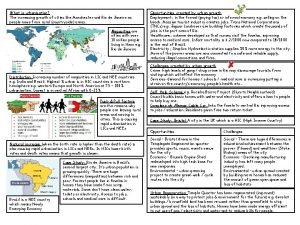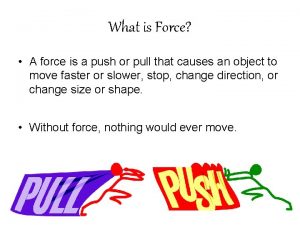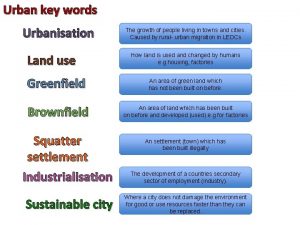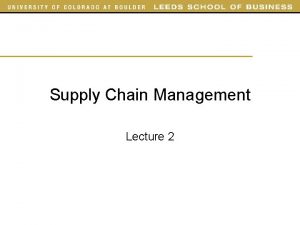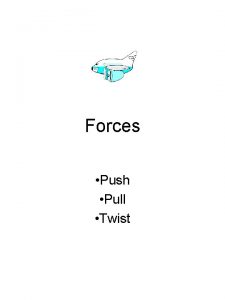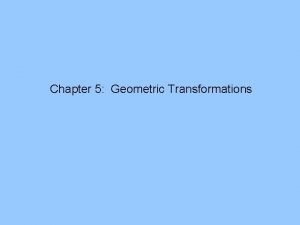Physics REVISION Forces Types of Forces Push Pull








- Slides: 8

Physics REVISION – Forces Types of Forces: Push Pull Friction Air Resistance/Drag Buoyancy/Upthrust Gravity Twist Elastic/stretch Static Electricity Magnetism Reaction • • A force is a push or pull on an object. Force is a vector (magnitude and direction). Forces cause an object… 1. Speed up - Like kicking a football 2. Slow down - Like drag or air resistance 3. Change direction - Like hitting a ball with a bat 4. Turn - Like turning a spanner 5. Change shape - Like stretching, twisting, compressing, bending • The unit for measuring forces are called newtons (N) For example: • The weight is the force of gravity pulling on you. Weight is force so it is measured in newtons. • Mass is the amount of matter which makes something up. The units for measuring mass are grams (g) and kilograms (kg) Friction There are two kinds of friction, based on how the two surfaces are moving relative to each other: Static friction The friction that exists between two surfaces that are not moving relative to each other. Kinetic/sliding friction The friction that exists between two surfaces that are moving relative to each other. In any situation, the static friction is greater than the kinetic friction. Have you ever tried to push a really big object? It feels easier to push the object than it did just to get it started. When it was still, you were trying to overcome the static friction (bigger force). When it finally started to move, you were now pushing against the kinetic friction (smaller force). Part of the kinetic energy used to move the object is transferred to heat energy in the process.

Physics REVISION – Newton’s 1 st law’s Newton’s First Law • A body in motion stays in motion at constant velocity and a body at rest stays at rest unless acted upon by a net external force. • This law is commonly referred to as the Law of Inertia. • People used to believe that force has to be acting on an object to keep it moving… however this is not the case. • In forces it is all out the net-force (or balance of the forces acting on the object. What does Newton’s First Law mean: • If there is zero net force on a body, it cannot accelerate, and therefore must move at constant velocity, which means – it cannot turn, – it cannot speed up, – it cannot slow down. – It cannot change shape The Book When an item touches a surface there is always a reaction force. If there wasn’t, the book would fall through the table. The forces on the book are equal. We know this because it is accelerating, changing direction or shape. Forces are shown by arrows in the direct the force is acting. The size (either width or length) can show the size of the force. The longer the length or bigger the width the bigger the force. The top diagram is a force diagram where as the bottom diagram a free body diagram. Both demonstrate the direction and size of the force. The Railway Trucks In the first diagram the forces on the truck are equal. This means we know the truck isn’t accelerating or changing direction. It means it is either moving at constant speed or stationary (not moving). In the second diagram the forward push (engine thrust) is bigger than the force stopping it moving such as friction and air resistance, meaning the truck is accelerating.

Physics REVISION – Newton’s 2 nd law - F=ma and Hooke’s Law F = ma Where F is Force in Newtons, m is mass in Kg and a is acceleration in m/s 2 Newtons 2 nd law of Motion: an object with unbalanced forces acting on it will accelerate in the direction of the resultant force. The acceleration is proportional to the net force and is in the direction which the net force acts. If an object is a rest it takes a force to move it. If it is moving it requires a force to change it’s speed or direction. The resistance to this change in velocity is inertia. The bigger the mass of an object the more inertia it has. Therefore the more mass an object has the more difficult it is to make it accelerate. Motion in a Circular Path If you place a ball on the end of string and swirl it around your head an inward force is required to keep the ball moving in a circular path. This force is provided by the tension in the string and without the ball would travel in a straight line. The inward force needed to make an object follow a circular path is called the Centripetal Force. More force is needed if the mass of the object increases, the speed increases and the length of the string (radius) increases. Hooke’s Law – F = K x X Where the spring constant is K F = load (N) and X = extension (mm) Elastic and Plastic If you use a ruler to flick a rubber across the room, the ruler will bend slightly then return to it’s original shape. Plastic is an elastic material however if you bend it too far it will snap or bend permanently out of shape. In comparison, if you stretch or bend plasticine, it retains it’s new shape. Materials like this are called plastic materials. Stretching a Spring As a force (N) or load is applied to a spring it stretches. The difference between the original and stretched length is it’s extension. When you plot Load vs Extension you get a straight line showing that extension and force are proportional to the limit of proportionality of the spring. Each spring has an elastic limit. Before this point when a spring is stretched it will return to it’s original length and shape. Beyond this the spring is permanently stretched and will eventually break. Hooke’s Law – Robert Hooke investigated springs in the 1600’s. If a material supports Hooke’s law, then below it’s elastic limit, the force applied is proportional to the load. This means if you divide the load by the extension you get the same value. This is know as the spring constant K.

Physics REVISION – Newton’s 3 rd Law – Action and Reaction Forces Newton’s third law of motion: If object A exerts a force on object B, then object B will exert an equal and opposite force on object A. For every action there exists an equal and opposite reaction. If A exerts a force F on B, then B exerts a force of -F on A. Resultant Force is the overall force acting on an object. It is the single force which has the same effect as all the other forces acting on it. reaction 500 N 100 N Use opposite forces: Opposite forces are very useful!! The large downward thrust of a rocket engine force results in it moving vertically upwards to overcome the weight of the rocket. Lift off!!!! Consider the flying motion of birds. A bird flies by use of its wings. The wings of a bird push air downwards. Since forces result from mutual interactions, the air must also be pushing the bird upwards. The size of the force on the air equals the size of the force on the bird; the direction of the force on the air (downwards) is opposite the direction of the force on the bird (upwards). For every action, there is an equal (in size) and opposite (in direction) reaction. Action-reaction force pairs make it possible for birds to fly. Resultant = 400 N weight Forces always act in pairs. Paired forces are known as the action and the reaction, one cannot exist without the other. e. g when a bullet fires from a gun it recoils in the opposite direction of bullet. As a skydiver falls due to gravity air resistance acts on it. A resultant force of 0 means no acceleration, change of speed or direction.

Physics REVISION – Newton’s 1 st Law, Scalars, Vectors & Parallelogram Rule The Monkey A monkey hangs on to a branch with both hands. If he isn’t moving then the forces acting on him must be balanced. The upward tension in the arms must being equal downward pull of his weight. Using the free body diagram FG = Fa 1 + Fa 2 Calculating Resultant Forces To calculate the resultant forces you simply add up the forces. Forces in the opposite direction have opposite signs. This is because force is a vector and has size and direction. Forces to the right could be positive which would make forces to the left negative. This means they cancel each other out resulting in a zero resultant force. It is possible to show the resultant force of 2 forces by using the Parallelogram Rule. You draw out a force diagram to scale. E. g 3 N and 4 N then the 3 N could be drawn as 3 cm and the 4 N for would be drawn as 4 cm. You then make a parallelogram as shown below using the force diagram. The diagonal of the parallelogram Is the resultant force. Alternatively vectors can be solved by trigonometry when the angles are given. Scalars and Vectors There are mathematical quantities that are used to describe the motion of objects. The quantity is either a vector or a scalar. Scalars only have magnitude or size. Vector quantities have both magnitude (size) and direction. For example, 11 m east and 15 ms-1 at 30° to the horizontal are both vector quantities. Scalar quantities include distance, speed, time and power, to name but a few. There are only six vector quantities: Displacement, velocity, acceleration, force, weight and momentum The size of the force is decided by the length of the diagonal. Use your original scale E. G. 1 cm is 1 N so if it 6. 4 cm long then the resultant force is 6. 4 N.

Physics REVISION – Forces, F=ma and Hooke’s Law F = ma Where F is Force in Newtons, m is mass in Kg and a is acceleration in m/s 2 If an object is a rest it takes a force to move it. If it is moving it requires a force to change it’s speed or direction. The resistance to this change in velocity is inertia. The bigger the mass of an object the more inertia it has. Therefore the more mass an object has the more difficult it is to make it accelerate. If you place a ball on the end of string and swirl it around your head an inward force is required to keep the ball moving in a circular path. This force is provided by the tension in the string and without the ball would travel in a straight line. The inward force needed to make an object follow a circular path is called the Centripetal Force. More force is needed if the mass of the object increases, the speed increases and the length of the string (radius) increases. Hooke’s Law – F = K x X Where the spring constant is K F = load (N) and X = extension (mm) Elastic and Plastic If you use a ruler to flick a rubber across the room, the ruler will bend slightly then return to it’s original shape. Plastic is an elastic material however if you bend it too far it will snap or bend permanently out of shape. In comparison, if you stretch or bend plasticine, it retains it’s new shape. Materials like this are called plastic materials. Stretching a Spring As a force (N) or load is applied to a spring it stretches. The difference between the original and stretched length is it’s extension. When you plot Load vs Extension you get a straight line showing that extension and force are proportional to the limit of proportionality of the spring. Each spring has an elastic limit. Before this point when a spring is stretched it will return to it’s original length and shape. Beyond this the spring is permanently stretched and will eventually break. Hooke’s Law – Robert Hooke investigated springs in the 1600’s. If a material supports Hooke’s law, then below it’s elastic limit, the force applied is proportional to the load. This means if you divide the load by the extension you get the same value. This is know as the spring constant K.

Physics REVISION – Turning effects and moments Calculating Moments M (Nm) = the Force F (N) x distance from the pivot d (m) Anticlockwise moment = 2 m x 300 N = 600 Nm Clockwise moment = 1. 5 m x 400 N = 600 Nm So the see saw is in Equilibrium. Principle of Moments If a system is in equilibrium (balanced), the sum of clockwise moments about any point is equal to the sum of anticlockwise moments about that point. Also if an object is in equilibrium, the forces on the object must be balance meaning the sum of the forces in one direction must equal the sum of forces in the opposite direction. Crane Issues Anticlockwise moment = 25 m x 4000 N = 100, 000 Nm Clockwise moment = 5 m x 20, 000 N = 100, 000 Nm The crane is in Equilibrium, any more load or if the load moved further from the pivot the anticlockwise moment would increase causing the crane to topple. A Balancing Beam Act Moments about A = 3 m x 400 N = 1200 Nm Moments about B = 4 m x 400 N = 1600 Nm The beam is moving therefore the forces are equal and split between the 2 supporting girls. If force X acts upward from girl B we know M (Nm) = F (N) x d (m) then M/d = F so force X = 1200/7 = 171. 4 N Because the forces are equal force Y acting up from girl B must be 400 N – 171. 4 N = 228. 6 N. We can check this using the moment about B 1600 Nm = 7 x 228. 6 N which is correct.

Physics REVISION – Centre of Mass Locating the Centre of Mass You can use a plumb line to work out the centre of mass of an irregular 2 D shape. 1. Make a hole in the edge of the shape and suspend the shape from one edge 2. Hang a plumb line and use it to draw a vertical line on the object. 3. Rotate the object, make another hole and suspend it again. 4. Again hang a plumb line and mark a vertical line on the object. 5. Repeat this 3 or 4 times. 6. Where the lines meet give the objects centre of mass. States of Equilibrium In stable equilibrium when the ball is rolled it will return to the original position. In an unstable state the ball is stable on briefly. In a neutral state the centre of mass of the ball always lies over the base. Stability – If the centre of mass remains over the base then an object will remain stable. As the COM passes over the edge of the base it will topple. The wider the base the more stable an object. Finding the centre of mass for symmetrical objects The centre of mass for a symmetrical object can be found easily. The axes of symmetry are marked on the object. The centre of mass is where the axes of symmetry cross.
